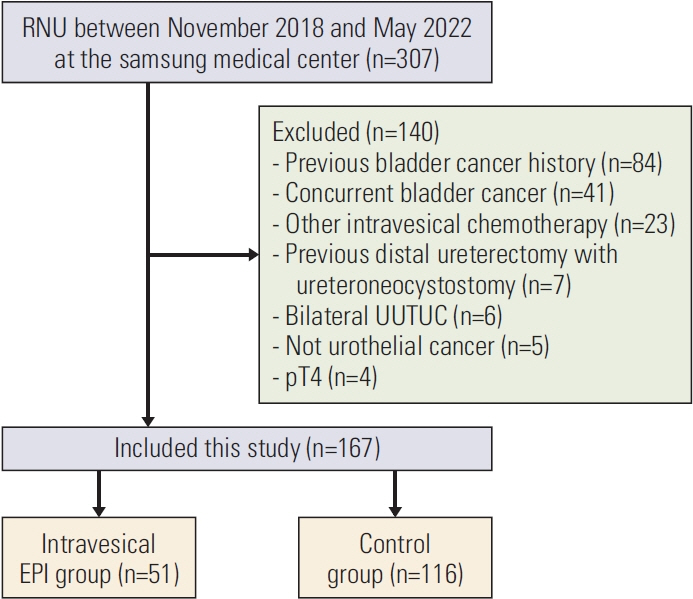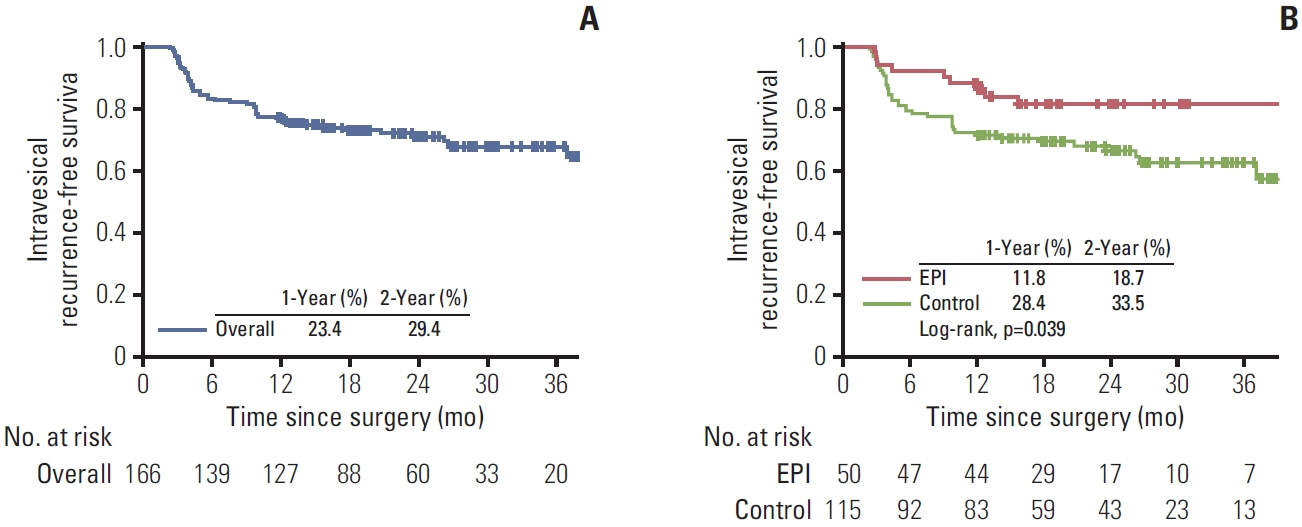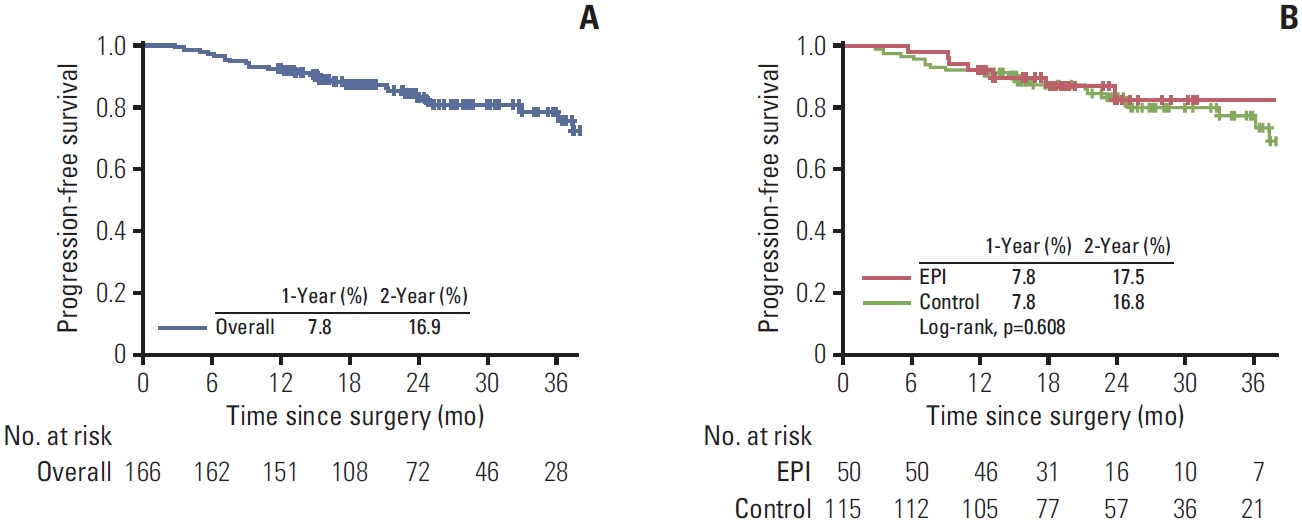Cancer Res Treat.
2024 Jul;56(3):877-884. 10.4143/crt.2023.1219.
Single Early Intravesical Instillation of Epirubicin for Preventing Bladder Recurrence after Nephroureterectomy in Upper Urinary Tract Urothelial Carcinoma
- Affiliations
-
- 1Department of Urology, Samsung Medical Center, Sungkyunkwan University School of Medicine, Seoul, Korea
- KMID: 2557674
- DOI: http://doi.org/10.4143/crt.2023.1219
Abstract
- Purpose
We aimed to assess the effectiveness of early single intravesical administration of epirubicin in preventing intravesical recurrence after radical nephroureterectomy for upper tract urothelial carcinoma.
Materials and Methods
Patients with upper tract urothelial carcinoma who underwent radical nephroureterectomy between November 2018 and May 2022 were retrospectively reviewed. Intravesical epirubicin was administered within 48 hours if no evidence of leakage was observed. Epirubicin (50 mg) in 50 mL normal saline solution was introduced into the bladder via a catheter and maintained for 60 minutes. The severity of adverse events was graded using the Clavien-Dindo classification. We compared intravesical recurrence rate between the two groups. Multivariate analyses were performed to identify the independent predictors of bladder recurrence following radical nephroureterectomy.
Results
Epirubicin (n=55) and control (n=116) groups were included in the analysis. No grade 1 or higher bladder symptoms have been reported. A statistically significant difference in the intravesical recurrence rate was observed between the two groups (11.8% at 1 year in the epirubicin group vs. 28.4% at 1 year in the control group; log-rank p=0.039). In multivariate analysis, epirubicin instillation (hazard ratio [HR], 0.43; 95% confidence interval [CI], 0.20 to 0.93; p=0.033) and adjuvant chemotherapy (HR, 0.29; 95% CI, 0.13 to 0.65; p=0.003) were independently predictive of a reduced incidence of bladder recurrence.
Conclusion
This retrospective review revealed that a single immediate intravesical instillation of epirubicin is safe and can reduce the incidence of intravesical recurrence after radical nephroureterectomy. However, further prospective trials are required to confirm these findings.
Keyword
Figure
Reference
-
References
1. Siegel RL, Miller KD, Fuchs HE, Jemal A. Cancer statistics, 2021. CA Cancer J Clin. 2021; 71:7–33.
Article2. Margulis V, Shariat SF, Matin SF, Kamat AM, Zigeuner R, Kikuchi E, et al. Outcomes of radical nephroureterectomy: a series from the Upper Tract Urothelial Carcinoma Collaboration. Cancer. 2009; 115:1224–33.
Article3. Xylinas E, Rink M, Margulis V, Karakiewicz P, Novara G, Shariat SF, et al. Multifocal carcinoma in situ of the upper tract is associated with high risk of bladder cancer recurrence. Eur Urol. 2012; 61:1069–70.
Article4. Roupret M, Seisen T, Birtle AJ, Capoun O, Comperat EM, Dominguez-Escrig JL, et al. European Association of Urology guidelines on upper urinary tract urothelial carcinoma: 2023 update. Eur Urol. 2023; 84:49–64.
Article5. Ito A, Shintaku I, Satoh M, Ioritani N, Aizawa M, Tochigi T, et al. Prospective randomized phase II trial of a single early intravesical instillation of pirarubicin (THP) in the prevention of bladder recurrence after nephroureterectomy for upper urinary tract urothelial carcinoma: the THP Monotherapy Study Group Trial. J Clin Oncol. 2013; 31:1422–7.
Article6. Fang D, Li XS, Xiong GY, Yao L, He ZS, Zhou LQ. Prophylactic intravesical chemotherapy to prevent bladder tumors after nephroureterectomy for primary upper urinary tract urothelial carcinomas: a systematic review and meta-analysis. Urol Int. 2013; 91:291–6.
Article7. Hwang EC, Sathianathen NJ, Jung JH, Kim MH, Dahm P, Risk MC. Single-dose intravesical chemotherapy after nephroureterectomy for upper tract urothelial carcinoma. Cochrane Database Syst Rev. 2019; 5:CD013160.
Article8. O’Brien T, Ray E, Singh R, Coker B, Beard R; British Association of Urological Surgeons Section of Oncology. Prevention of bladder tumours after nephroureterectomy for primary upper urinary tract urothelial carcinoma: a prospective, multicentre, randomised clinical trial of a single postoperative intravesical dose of mitomycin C (the ODMIT-C Trial). Eur Urol. 2011; 60:703–10.
Article9. Dobe TR, Califano G, von Rundstedt FC, Ouzaid I, Albisinni S, Aziz A, et al. Postoperative chemotherapy bladder instillation after radical nephroureterectomy: results of a European survey from the Young Academic Urologist Urothelial Cancer Group. Eur Urol Open Sci. 2020; 22:45–50.
Article10. Seisen T, Granger B, Colin P, Leon P, Utard G, Renard-Penna R, et al. A systematic review and meta-analysis of clinicopathologic factors linked to intravesical recurrence after radical nephroureterectomy to treat upper tract urothelial carcinoma. Eur Urol. 2015; 67:1122–33.
Article11. Chou R, Selph S, Buckley DI, Fu R, Griffin JC, Grusing S, et al. Intravesical therapy for the treatment of nonmuscle invasive bladder cancer: a systematic review and meta-analysis. J Urol. 2017; 197:1189–99.
Article12. Elmamoun MH, Christmas TJ, Woodhouse CR. Destruction of the bladder by single dose mitomycin C for low-stage transitional cell carcinoma (TCC): avoidance, recognition, management and consent. BJU Int. 2014; 113:E34–8.13. Nieuwenhuijzen JA, Bex A, Horenblas S. Unusual complication after immediate postoperative intravesical mitomycin C instillation. Eur Urol. 2003; 43:711–2.
Article14. Messing EM, Tangen CM, Lerner SP, Sahasrabudhe DM, Koppie TM, Wood DP Jr, et al. Effect of intravesical instillation of gemcitabine vs saline immediately following resection of suspected low-grade non-muscle-invasive bladder cancer on tumor recurrence: SWOG S0337 randomized clinical trial. JAMA. 2018; 319:1880–8.
Article15. Gontero P, Cattel L, Paone TC, Milla P, Berta G, Fiorito C, et al. Pharmacokinetic study to optimize the intravesical administration of gemcitabine. BJU Int. 2010; 106:1652–6.
Article16. Oddens JR, van der Meijden AP, Sylvester R. One immediate postoperative instillation of chemotherapy in low risk Ta, T1 bladder cancer patients. Is it always safe? Eur Urol. 2004; 46:336–8.
Article17. Sylvester RJ, Oosterlinck W, Holmang S, Sydes MR, Birtle A, Gudjonsson S, et al. Systematic review and individual patient data meta-analysis of randomized trials comparing a single immediate instillation of chemotherapy after transurethral resection with transurethral resection alone in patients with stage pTa-pT1 urothelial carcinoma of the bladder: which patients benefit from the instillation? Eur Urol. 2016; 69:231–44.
Article18. Habuchi T, Takahashi R, Yamada H, Kakehi Y, Sugiyama T, Yoshida O. Metachronous multifocal development of urothelial cancers by intraluminal seeding. Lancet. 1993; 342:1087–8.
Article19. Catto JW, Hartmann A, Stoehr R, Bolderson E, Rehman I, Rosario DJ, et al. Multifocal urothelial cancers with the mutator phenotype are of monoclonal origin and require panurothelial treatment for tumor clearance. J Urol. 2006; 175:2323–30.
Article20. Yamashita S, Ito A, Mitsuzuka K, Tochigi T, Namima T, Soma F, et al. Clinical implications of intravesical recurrence after radical nephroureterectomy for upper urinary tract urothelial carcinoma. Int J Urol. 2016; 23:378–84.
Article21. Hafner C, Knuechel R, Stoehr R, Hartmann A. Clonality of multifocal urothelial carcinomas: 10 years of molecular genetic studies. Int J Cancer. 2002; 101:1–6.
Article22. Harris AL, Neal DE. Bladder cancer: field versus clonal origin. N Engl J Med. 1992; 326:759–61.23. Ryoo H, Kim J, Kim T, Kang M, Jeon HG, Jeong BC, et al. Effects of complete bladder cuff removal on oncological outcomes following radical nephroureterectomy for upper tract urothelial carcinoma. Cancer Res Treat. 2021; 53:795–802.
Article24. Nowak L, Krajewski W, Chorbinska J, Kielb P, Sut M, Moschini M, et al. The impact of diagnostic ureteroscopy prior to radical nephroureterectomy on oncological outcomes in patients with upper tract urothelial carcinoma: a comprehensive systematic review and meta-analysis. J Clin Med. 2021; 10:4197.
Article
- Full Text Links
- Actions
-
Cited
- CITED
-
- Close
- Share
- Similar articles
-
- Urothelial Tumors of the Upper Urinary Tract: Multiplicity and Prognostic Variables
- Identification of Significant Prognostic Tissue Markers Associated with Survival in Upper Urinary Tract Urothelial Carcinoma Patients Treated with Radical Nephroureterectomy: A Retrospective Immunohistochemical Analysis Using Tissue Microarray
- Routine Use of Single Instillation of Epirubicin after Transurethral Resection of Bladder Tumor - Should It Be Done in Korean Patients?
- Risk Factors for Subsequent Bladder Cancer Recurrence following Radical Surgery for Upper Urinary Tract Urothelial Cancer
- Significant clinicopathologic prognostic factors for bladder recurrence, progression, and cancer-specific survival after surgery among patients with upper urinary tract urothelial carcinoma




